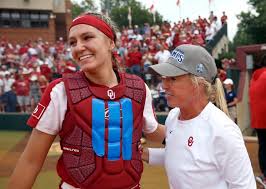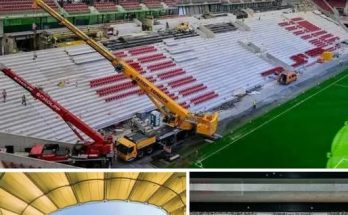In a monumental announcement that sent shockwaves through the collegiate softball world, the University of Oklahoma revealed plans for an unprecedented $5.3 billion renovation of Marita Hynes Field—a move that instantly reshapes the trajectory of the sport and elevates its prestige on a global scale. With the program already cemented as a dynasty under the leadership of legendary head coach Patty Gasso, this staggering investment signifies more than just a state-of-the-art stadium. It’s a declaration of purpose, power, and permanence—an affirmation that Oklahoma Softball isn’t just leading the way in college sports but redefining what’s possible.
The numbers alone are hard to grasp. At $5.3 billion, the Marita Hynes Field renovation project dwarfs any collegiate or professional softball investment in history. For context, even the most luxurious Major League Baseball stadiums pale in comparison. This isn’t merely a new facility—it’s an empire in the making. Oklahoma’s vision transcends brick and mortar, aiming to create a mecca for women’s athletics that inspires future generations, draws international attention, and stands as a bold counterpoint to decades of inequity in funding and recognition for women’s sports.
“This is the gold standard,” said Athletic Director Joe Castiglione during the press conference, his voice steady and proud as he addressed a sea of crimson and cream supporters. “Not just for softball, not just for women’s sports, but for college athletics as a whole. What we are building is a beacon—a symbol of excellence, equality, and enduring commitment to our student-athletes.”
The scope of the renovation defies imagination. According to early blueprints, the new Marita Hynes Field will feature a retractable roof for year-round play, seating capacity of 40,000, and the world’s first subterranean bullpen and pitching lab, designed in collaboration with NASA engineers to enhance biomechanics and reduce injury. There will be a multi-level fan engagement center complete with virtual reality experiences, interactive training simulators, a museum chronicling the history of women’s sports, and a state-of-the-art sports medicine wing staffed by a team of Olympic-level professionals. The stadium will be powered entirely by sustainable energy, including solar panels, wind turbines, and rainwater recycling systems.
But beyond the flash and innovation, the heartbeat of this historic project lies in the athletes and coaches who built the Oklahoma program from humble beginnings to a juggernaut that has dominated the national stage. Patty Gasso, already regarded as one of the greatest coaches in any sport, stood alongside university officials as the design renderings were unveiled. Tears welled in her eyes as she gazed at the future home of the program she helped turn into a national treasure.
“This is more than a stadium,” Gasso said, her voice cracking with emotion. “It’s a legacy. It’s every young girl who ever dreamed of stepping on this field. It’s every athlete who wore this jersey with pride. And now, it’s a gift to the future—a stage worthy of their greatness.”
Indeed, Oklahoma Softball has set an impossible standard for others to chase. The Sooners have won seven national championships—five of them in the last decade—and boast a roster that often reads like an All-American dream team. Their dominance isn’t just measured in trophies but in impact. Gasso’s teams have consistently led the nation in attendance, TV ratings, and social media engagement, demonstrating the enormous commercial and cultural power of women’s college softball when given the platform to thrive.
That platform is now expanding beyond measure. In addition to the stadium, the renovation includes the construction of a global softball academy on site, which will host international competitions, Olympic development camps, and cross-cultural exchange programs. A partnership with ESPN will ensure the facility becomes a hub for broadcasting premier women’s events, further solidifying Oklahoma as the epicenter of the sport.
“This project will change lives,” said Sooner star Kinzie Hansen, who returned for her senior season in 2025 after winning three national titles. “We already had the best program in the country. Now we’re going to have the best home, the best resources, and the biggest platform. There’s never been a better time to be a softball player, and there’s no better place to be one than Oklahoma.”
The announcement reverberated instantly across social media, where athletes, coaches, alumni, and fans hailed it as a game-changer. Rival programs expressed admiration—and perhaps envy—while softball legends like Jennie Finch, Cat Osterman, and Monica Abbott praised the Sooners for investing boldly in the sport’s future.
“This is what progress looks like,” Finch tweeted. “Thank you @OU_Softball for showing the world what women’s sports are worth. Every little girl watching today just had her dreams validated.”
Even beyond the softball community, the move was seen as a pivotal moment for Title IX and gender equity in athletics. For decades, women’s sports programs have operated on budgets that were mere fractions of those allotted to their male counterparts. The Oklahoma renovation challenges that paradigm not with words, but with action—and billions of them. It sets a precedent that other programs will be pressured to follow, lest they fall behind in the eyes of recruits, fans, and corporate sponsors who now see the value in women’s sports more clearly than ever.
“This investment is not an expense—it’s a vision,” said Oklahoma President Joseph Harroz Jr. “It’s a recognition that when we believe in women’s sports, and back that belief with resources, the return isn’t just financial. It’s generational. It’s transformational.”
Indeed, the economic ripple effect of the renovation is expected to be massive. Local businesses in Norman anticipate a surge in tourism and game-day traffic. New hotels, restaurants, and entertainment venues are already in the planning stages, creating jobs and rejuvenating the area around the campus. The university expects the project to be self-sustaining within ten years, buoyed by increased ticket sales, naming rights, merchandise, and global events hosted at the facility.
While many marvel at the dollar amount, those closest to the program say the true value of the renovation can’t be measured in money.
“This is about dignity,” said alumna and two–time All–American Lauren Chamberlain. “It’s about respect. For so long, softball has been overlooked. We’ve played in outdated stadiums, worn hand–me–downs, and fought for every inch of exposure. Oklahoma just turned the lights



